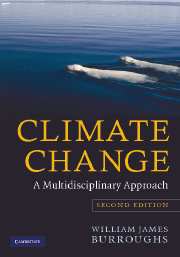Book contents
- Frontmatter
- Contents
- Preface to the second edition
- 1 Introduction
- 2 Radiation and the Earth's energy balance
- 3 The elements of the climate
- 4 The measurement of climate change
- 5 Statistics, significance and cycles
- 6 The natural causes of climate change
- 7 Human activities
- 8 Evidence of climate change
- 9 Consequences of climate change
- 10 Modelling the climate
- 11 Predicting climate change
- Glossary
- Bibliography
- Index
4 - The measurement of climate change
Published online by Cambridge University Press: 05 June 2012
- Frontmatter
- Contents
- Preface to the second edition
- 1 Introduction
- 2 Radiation and the Earth's energy balance
- 3 The elements of the climate
- 4 The measurement of climate change
- 5 Statistics, significance and cycles
- 6 The natural causes of climate change
- 7 Human activities
- 8 Evidence of climate change
- 9 Consequences of climate change
- 10 Modelling the climate
- 11 Predicting climate change
- Glossary
- Bibliography
- Index
Summary
The one duty we have to history is to rewrite it.
Oscar Wilde.To be certain about how the climate has changed in the past we would need reliable measurements of the relevant parameters (e.g. temperature, rainfall, cloud cover, extent of winter snow and sea-ice, etc.) for representative points around the globe, for regular intervals of time going back as far as we wanted. In practice we have none of these things. Even with modern observations systems there are gaps in our knowledge of how the global climate is changing. Going back in time the problems mount. The whole process of improving the measurement of climate change is designed to fill in gaps in our knowledge of the past and establish a better foundation for the theories of why changes have occurred. The objectives of this chapter are:
(a) to explore briefly the most essential features of various methods of measuring past climatic conditions;
(b) to establish their strengths and weaknesses; and
(c) to investigate whether the various measurements can be combined to provide a more coherent picture of climate variability and climate change.
This involves going over some well-worn ground concerning the measurement of meteorological parameters. To achieve our objectives we must identify those features of measurement that limit our ability to draw conclusions about how the climate has behaved in the past and how it is currently changing.
- Type
- Chapter
- Information
- Climate ChangeA Multidisciplinary Approach, pp. 81 - 120Publisher: Cambridge University PressPrint publication year: 2007



